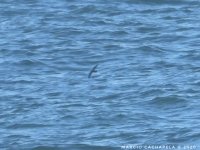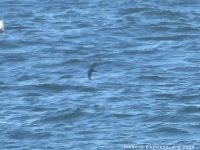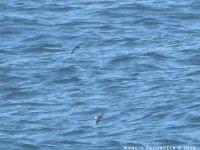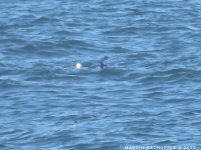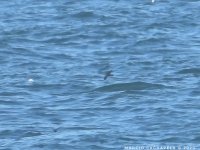Hello Márcio,
obviously, this is a very interesting record. I can imagine it got your heart pumping. I've been avoiding to comment on this thread, but I guess it can't do much harm.
I do have some experience with this species, but ironically probably it doesn't put me in a much better place to comment than the ones that already commented above, as I'll explain next (it includes some unnecessary detail, but perhaps it'll be interesting to read).
Over several years (2007-2009) I've found around 10 Swinhoe's Storm Petrels in the Selvagens Islands (all in Selvagem Grande), some of them perhaps the same over several years and many were recorded several times in each year. These were all found due to very solitary night work specifically directed at this species, covering all of the island surface. I found the first (the one in plate 210 of the above linked paper) following indications from Frank Zino, but all of the following were the result of perseverance. It involved mostly listening, although some were captured either in mist nests or inside easily accessible burrows; others just flew over, calling, and others were inside inaccessible burrows; at one point I found a male and a female together inside one burrow but these were only sound recorded (males and females have different calls: the pitch is different). They can actually be considered to be expected there, in my opinion. Despite all my efforts I never managed to confirm they were breeding there, and my data seems to suggest they are actually not (somewhat surprisingly, for me), at least not regularly: they do congregate there though. The biggest difficulty involved with finding them by sound there is because the island harbours a massive Cory's Shearwater colony (40k pairs?) and on most nights the sound of their calls/song is basically deafening; on some nights though (due to their cycle) it gets more silent and it makes the task more possible.
Some of the details were published here:
https://www.researchgate.net/public...rds_and_relationships_within_the_Hydrobatinae
So, despite having had quite a few in the hand and having heard it "frequently", I have no experience with this species at sea at all, which is what this record is all about.
My perception/experience is thus a bit biased, but of course in terms of probability, there's nothing against it being monorhis. The species "must be around", and birds being found in the British Isles and elsewhere to the north might pass on Portuguese waters. There have been also records from around Madeira and the Azores. However, assessing a record of a rarity has little to do with probabilities (although these are also taken into account) and more about concrete evidence that is presented (I'm imagining you'd want to submit this record).
From your short description and photos, the bird is clearly an Oceanodroma. There have been records of all dark small petrels on the Portuguese coast (mainland) in the past, with only some of those being submitted to the Portuguese Rarities Committee; none has ever been accepted. Usually people had trouble to rule out Bulweria on their descriptions, either because they had no previous experience of the species or because they had not seen enough detail. This aspect is resolved in your observation: the bird is a clear Oceanodroma.
Now you'd want to see what evidence can be extracted from the photos that can rule out some species and confirm your ID (basically those included in the Bob Flood's paper, above); one thing that people sometimes forget when submitting a record with photos is that supplementary information, as detailed as possible, can and should be included, in order to explain the photos presented (e.g. are they showing the upperparts or the underparts? etc) and to complement that visual information, focusing on all that is not possible to extract from those pics but that you actually saw in the field. In this case you shortly described the flight action, but perhaps you can add some more detail (that you actually saw and remember).
You mentioned that someone said that wings were not Leach's S-Petrel like; I'm not sure you can say that from such photos, it's tricky and a bit wishful thinking: remember that a photo always captures a fraction of a second and many times less than typical shapes are captured. My experience of the species at sea comes from seeing videos of it, and from those the shape on your photos seems ok.
Of your 5 photos, I believe only pic 3 shows the upperparts? But I'm not 100% sure of this. If yes, the bird seems to have all dark upperparts (but a closer inspection could change this, the photo resolution is really low); it's here that it's important to provide additional info, explaining (if this is the case) that you confirmed the colouration while watching the bird.
On the remaining 4 pics it's possible to see a slightly paler underwing band, which is ok for Swinhoe's. On some pics there's a suggestion of a slightly paler head, which is also good.
The thing is not so much what you can see on your photos (nothing of which rules out Swinhoe's), it's more about the diagnostic features that you cannot see there (pale primary quills, exact colours and patterns, tail shape, etc).
It looks good to me, in terms of "probabilities" you are also ok (it would be more extraordinary to find any of the confusion possibilities), and I think it most likely is one. But in the end, for it to be accepted (by the rarities committee, if that's what you're aiming at) it will come down to the individual opinions of the committee members (I'm not there anymore, otherwise I definitely would not comment here), so who knows. I hope this helps, somehow.
And of course, congratulations for the find, it's a crazy species to see from land!




